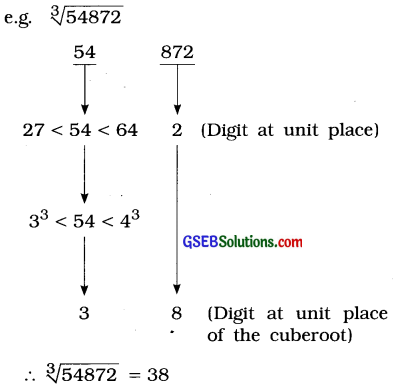This GSEB Class 8 Maths Notes Chapter 7 Cubes and Cube Roots covers all the important topics and concepts as mentioned in the chapter.
Cubes and Cube Roots Class 8 GSEB Notes
→ Taking one and the same number three times and multiplying, we get the cube of that number. In other words, repeated multiplication of a number three times gives the cube of that number,
e.g. 1 × 1 × 1 = 13 = 1
2 × 2 × 2 = 23 = 8
3 × 3 × 3 = 33 = 27
→ Remember that the cube of 1 is 1, the cube of 2 is 8 and the cube of 3 is 27. Moreover, the cube root of 1 is 1, the cube root of 8 is 2 and the cube root of 27 is 3.
→ Symbolically:
\(\sqrt[3]{1}\) = 1. Read as cube root of 1 is equal to 1
\(\sqrt[3]{8}\) = 2. Read as cube root of 8 is equal to 2
\(\sqrt[3]{27}\) = 3. Read as cube root of 27 is equal to 3
Thus, 1, 8, 27, 64, 125,… are positive perfect cubes as they are the cubes of natural numbers.
→ Among the numbers from 1 to 100, there are four perfect cubes 1, 8, 27 and 64.
→ Every natural number has a cube, but every natural number does not have a cube root.
→ Definition: The cube of any integer is called a perfect cube.
→ Multiplying the square of a number by the number, we get the cube of that number.
e.g. The square of 2 is 4. Multiplying 4 by 2,
i. e., 4 × 2 = 8 which is the cube of 2, and so on.
(Note: Cubes of odd numbers are always odd while cubes of even numbers are always even. ]
→ If the digit at units place of a number is 1, 4, 5, 6, 9 or 0, the digit at units place of the cube of that number is also the same digit, i.e., 1, 4, 5, 6, 9 or 0 respectively.
→ If the digit at units place of a number is 2, the digit at units place of the cube of that number is 8.
→ If the digit at units place of a number is 8, the digit at units place of the cube of that number is 2.
→ If the digit at units place of a number is 3, the digit at units place of the cube of that number is 7.
→ If the digit at units place of a number is 7, the digit at units place of the cube of that number is 3.
→ If the digit at units place of a number is 0, last three digits of the cube of that number are zeros.
e.g. 103 = 10 × 10 × 10 = 1000
203 = 20 × 20 × 20 = 8000
303 = 30 × 30 × 30 = 27,000
403 = 40 × 40 × 40 = 64,000
![]()
→ Hardy – Ramanujan Numbers :
Numbers which can be expressed as a sum of two cubes in two different ways are called Hardy – Ramanujan Numbers,
e.g. 1729 = 1728 + 1 = 123 + 13, and
1729 = 1000 + 729 = 103 + 93
→ 1729 is called a ‘dull number’.
→ There are an infinitely many such numbers. Few are 4104 (2, 16; 9, 15), 13832 (18, 20; 2, 24) and so on.
→ The cube root of any perfect cube made up of at the most six digits can easily be found by logical inference (estimation).

Explanation:
- Split the given number into two parts :
- The number formed by the digits at the hundreds, tens and units place of the given number. Here, it is 872.
- The number formed by the remaining digits in the same order. Here, it is 54.
- In the first part 872, the digit at units place is 2, which gives 8 at the units place of the cube root.
- Find two consecutive perfect cubes between which the number in the second part lies. Here, the number in the second part, i.e., 54 lies between 27 and 64. Thus, 33 < 54 < 43. Now, 54 is greater than the cube of 3. Hence, the digit at tens place of the cube root of the given number is 3.
∴ \(\sqrt[3]{54872}\) = 38
→ Similarly, \(\sqrt{148877}\) = 53 as 53 < 148 < 63 and 7 at units place of the perfect cube gives 3 at the units place of the cube root.